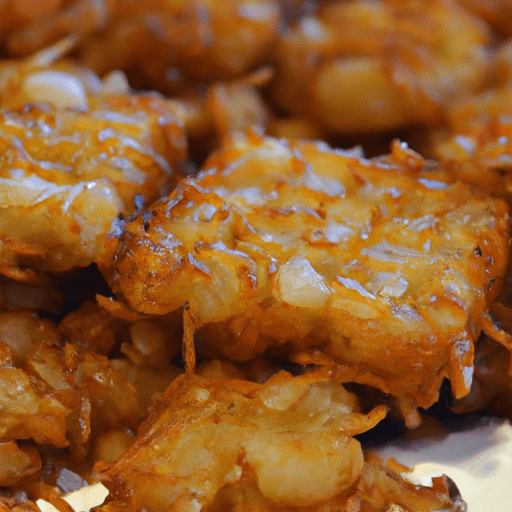The Delightful World of Cooked Hashbrowns
Have you ever indulged in the crispy, golden goodness of a perfectly cooked hashbrown? These popular breakfast staples have gained a significant following for good reason. Deliciously versatile, bursting with flavor, and steeped in rich history, cooked hashbrowns are a beloved favorite in countless kitchens around the world.
Exploring the Taste of Hashbrowns
Cooked hashbrowns are a masterful blend of grated or shredded potatoes, cooked until they form a crunchy and golden brown exterior while maintaining a soft and tender interior. The taste is distinctly comforting, with notes of earthiness and a gentle sweetness. The outer layer provides a satisfying crunch, revealing a warm and fluffy center that practically melts in your mouth.
Common Uses in Cooking
Hashbrowns are the perfect canvas for culinary creativity, acting as an excellent base for a myriad of flavor combinations. While breakfast remains their most common domain, these versatile spuds are not limited to just that one meal. Here are a few delicious ways to enjoy cooked hashbrowns:
- Traditional Breakfast: Served alongside eggs, bacon, and toast, hashbrowns complete the classic breakfast experience.
- Hashbrown Casserole: Layered with cheese, onions, and cream, this dish makes a delightful side for brunch or potlucks.
- Hashbrown Waffles: Transform your hashbrowns into a delightful and crispy waffle, perfect for topping with eggs or avocado.
- Hashbrown Balls: Rolled into bite-sized balls and lightly fried, these make a fantastic appetizer or snack.
- Hashbrown Tacos: Stuff a tortilla with scrambled eggs, cooked hashbrowns, salsa, and cheese for a breakfast taco sensation.
Nutritional Value
Beyond being a delicious treat, cooked hashbrowns boast surprising nutritional value. Potatoes, the star ingredient, are packed with essential vitamins and minerals. They are an excellent source of vitamin C, providing more than half of the recommended daily value. Additionally, they contain potassium, vitamin B6, and dietary fiber. However, it’s important to note that cooking methods and accompanying ingredients can affect the overall nutritional content.
While hashbrowns can be high in carbohydrates and calories when prepared with excess oil or deep-frying, healthier cooking methods can easily be employed. Consider baking or air frying your hashbrowns for a lighter alternative that still maintains that irresistible crispiness.
A Dash of History and Fascinating Facts
The exact origins of hashbrowns are a subject of debate. Some believe the concept emerged from Switzerland, where “rösti” was initially created as a peasant breakfast dish in the 19th century. Others credit the American Midwest for popularizing hashbrowns in the early 1900s.
Did you know that Hashbrown Casserole, also known as “funeral potatoes,” gained its name from its frequent appearance at post-funeral gatherings? It quickly became a comforting staple, providing solace during challenging times.
Additionally, hashbrowns made their way into American fast-food chains, with McDonald’s introducing the iconic “McDonald’s Hash Browns” in the 1970s. Nowadays, they’re found everywhere from hearty diners to stylish brunch spots—but cooking them at home will always hold its own special charm.
Let’s Get Cooking!
To make your own cooked hashbrowns, start by peeling and grating potatoes. Squeeze out the excess moisture using a clean cloth or paper towel. Season with salt, pepper, and any desired herbs or spices. Heat a skillet with oil or butter over medium heat and shape the grated potatoes into patties. Cook until golden brown on both sides, then serve hot, ready to savor every crispy bite.
Whether you enjoy them as part of a traditional breakfast or get creative with exciting toppings and variations, cooked hashbrowns bring a delightful crunch and comforting flavor to the table. So, grab your skillet, gather your ingredients, and dive into the delightful world of cooked hashbrowns!
Facts about Cooked Hash Browns:
Origin: Hash browns are a popular dish made from grated or finely chopped potatoes. The exact origin of hash browns is not well-documented, but they are believed to have European roots, possibly originating in Switzerland or Germany.
Common Uses: Hash browns are commonly served as a breakfast or brunch dish in many countries. They are often fried or cooked on a griddle until crispy. Hash browns can be enjoyed on their own, topped with various ingredients like cheese, bacon, or herbs, or served as a side dish with eggs, sausages, or other breakfast foods.
Nutritional Benefits: Hash browns are a good source of carbohydrates and provide a moderate amount of dietary fiber when made from whole potatoes. They also contain essential vitamins and minerals like vitamin C, vitamin B6, potassium, and manganese. However, the nutritional content may vary depending on the cooking method and additional ingredients like oil or butter used.
Unique Properties: The key characteristic of hash browns is their crispy texture. This is achieved by grating or finely chopping the potatoes, which exposes a larger surface area to heat and encourages browning. To achieve a crispy exterior while maintaining a tender interior, it is important to remove excess moisture from the potatoes before cooking.
Historical Significance: While the exact history of hash browns is unclear, potatoes have been a staple food for centuries and were introduced to Europe by Spanish explorers in the 16th century. Potatoes quickly gained popularity, and recipes for grated and fried potato dishes began appearing in European cookbooks in the 18th century. These early versions of hash browns may have inspired the dish as we know it today.
Please note that in different regions, variations of hash browns may exist with differing ingredients, cooking methods, and names.




Use the share button below if you liked it.
It makes me smile, when I see it.